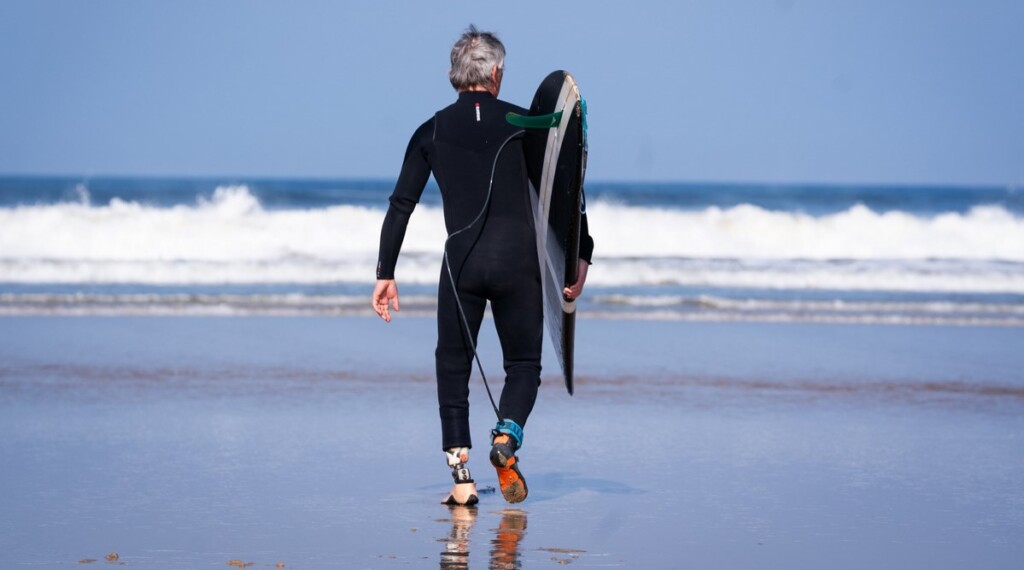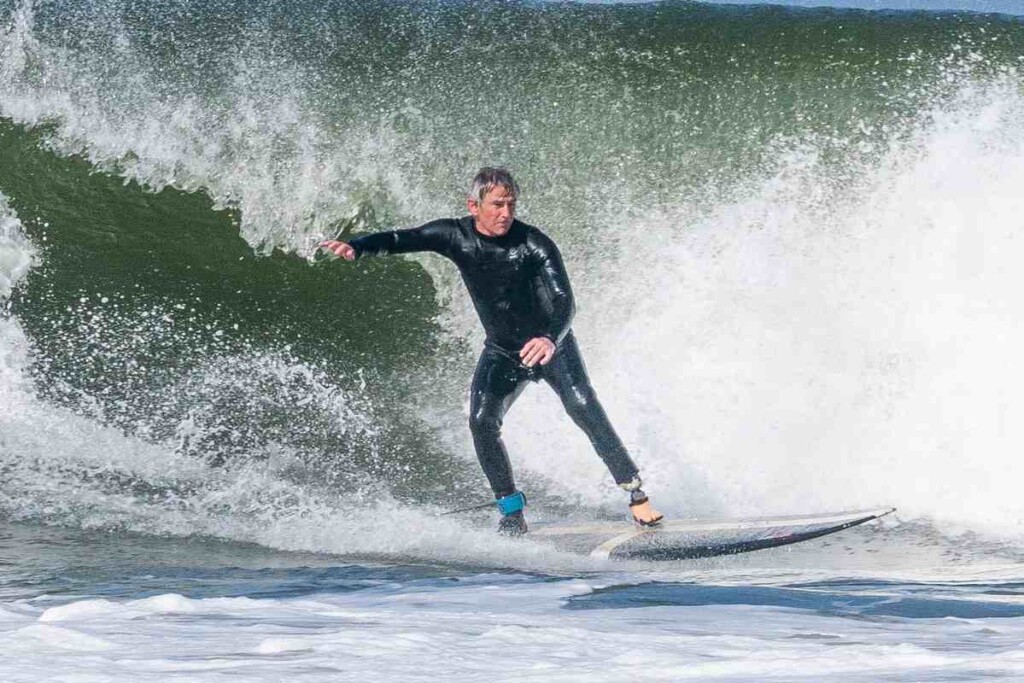 Pegleg Bennett during a surf session at Perranporth Beach – credit, William Dax, SWNS
Pegleg Bennett during a surf session at Perranporth Beach – credit, William Dax, SWNS‘Pegleg’ Bennett was born with a birth defect that led to the amputation of his foot when he was a baby, but the 55-year-old never let it impede the pursuit of his passion: surfing.
The father of three has traveled the world surfing, making it to some of the most famous big wave surfing spots in places like Indonesia, Hawaii, Australia, and Portugal. He’s also represented his country in a para-surfing championship, and pioneered some best practices in making prosthetic legs for surfers.
Bennett was born with the ankle of his left leg missing and his foot looking twisted and mangled.
At the hospital, his parents were given the choice of amputation—which the doctors said would actually ensure he had better quality of living.
“The ocean is my happy place,” said Bennett, who legally changed his name to Pegleg—a childhood nickname—in 2016. “When I’m riding a wave nothing else matters, nothing else is there—it is just me and that wave and feeling that glide and that ride.”
He told the British media outlet SWNS that he grew up a “water baby” and given that his father was a big swimmer, the progression to surfing came naturally, despite his missing foot.
He describes “harassing” the UK’s National Health Service for years, “and eventually they gave me what they call a ‘beach activities leg’ and then my surfing progressed at a phenomenal rate after that.”
 Pegleg Bennett during a surf session at Perranporth Beach – credit, William Dax, SWNS
Pegleg Bennett during a surf session at Perranporth Beach – credit, William Dax, SWNSAfter learning to surf on it, Bennett drilled holes in that first prosthetic leg to improve its functionality, and this led to a phenomenal surfing career.
“There is a big wave spot in Portugal called Nazaré,” he said, at the start of listing every spot he’s enjoyed. “I have also done the entire European coast, I have driven the Moroccan coast right down into the occidental Sahara, Hawaii, all over the States, Indonesia, Japan. I have surfed on the Arctic circle.”
His new leg, made from carbon fiber and titanium, has taken his surfing to a “new level”, he said.
AQUATIC AMPUTEES: This Cheap, Amphibious, 3D-Printed Prosthetic Means That Amputees Can Now Enjoy the Water Without Stress
“I have got a surf specific leg—it’s got a titanium ankle joint in it so I can stand on the board a lot better than I used to.”
For his whole adult life, Bennett has been at the crest of the wave of para-surfing, which has undergone a revolutionary transformation.
The turning point came in 2015 when the International Surfing Association (ISA) hosted the first Adaptive Surfing World Championships—bringing together surfers from all the nations.
Since then, the sport has exploded in popularity with the adaptive surfing, or para-surfing, community becoming the fastest-growing segment of the surfing world. Team England para-surfing team is now ranked seventh in the world, led by Bennett’s instruction and inspiration.
He explained that within the para-surfing community there are people with all kinds of disabilities.
“I coached someone with cerebral palsy, MS, I have got some blind guys that I coach, obviously some amputees,” he said. “If somebody has got a disability and they want to get in the ocean and catch waves, I can make it happen.”
OTHER SURFING STORIES: Olympic Kite Surfer Saves Drowning Woman in Dramatic Video – WATCH
“I don’t believe in barriers. I believe in we can do it.”
Although para-surfing narrowly missed out on the 2028 Los Angeles Games, there is strong hope for its inclusion in the Paralympics in Brisbane in 2032, and the opportunities that could bring for extra funding.
SHARE Pegleg’s Inspirational Story With Your Friends who Need A Pick-Me-Up…
Source link

